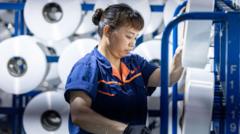China's economy has shown unexpected strength, growing by 5.2% in the three months ending in June, exceeding the 5.1% forecast set by economists even in the face of steep tariffs imposed by US President Donald Trump and an ongoing crisis in the property market. Although this figure is lower than the previous quarter's growth, officials claim that the country has dodged a significant downturn thanks to interventions from Beijing to stimulate growth and a tentative trade truce with Washington.
The National Bureau of Statistics commented that the economy exhibited resilience, managing to "withstand pressure and made steady improvements despite challenges." Notably, manufacturing saw a robust expansion of 6.4%, driven by increasing demand for advanced technologies like 3D printing, electric vehicles, and industrial robotics. The services sector, including vital industries like finance and technology, also reported positive growth.
However, the report indicated a slowdown in retail sales growth, which fell to 4.8% year-on-year in June, down from a 6.4% increase in May. Additionally, new home prices dropped in June, marking the fastest decline in eight months, underscoring the ongoing struggles in China's real estate market despite various government measures aimed at stabilizing property prices.
Though analysts anticipated a more severe impact from the tariffs, economist Gu Qingyang from the National University of Singapore noted that the nation remains "highly resilient." A contributor to this growth was an increase in exports, as companies rushed to deliver goods before the implementation of any additional tariffs or revisions to export policies.
Looking ahead, uncertainties loom over the second half of the year, with Professor Gu suggesting that more robust government stimulus may become necessary. Despite these challenges, observers believe that China could still meet its annual growth target of around 5%, though some economists predict that the target could be missed, estimating a bottom floor of 4% to be politically acceptable.
The trade tensions between Presidents Xi Jinping and Trump have resulted in significant tariffs, with the US imposing a 145% tariff on certain Chinese products, while Beijing responded with a 125% duty on US goods. Negotiations in Geneva and London paused these tariffs, with both sides granted until August 12 to reach a comprehensive trade agreement. Moreover, Washington has enforced heavy tariffs on countries closely tied economically to China.



















